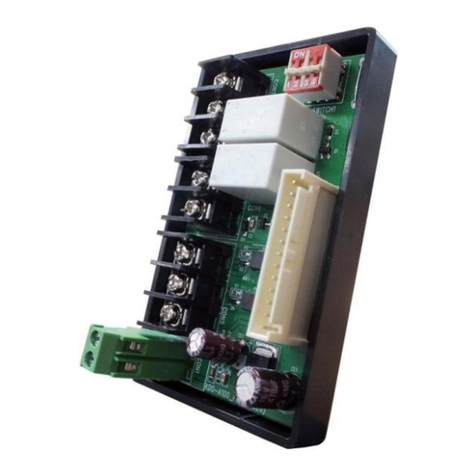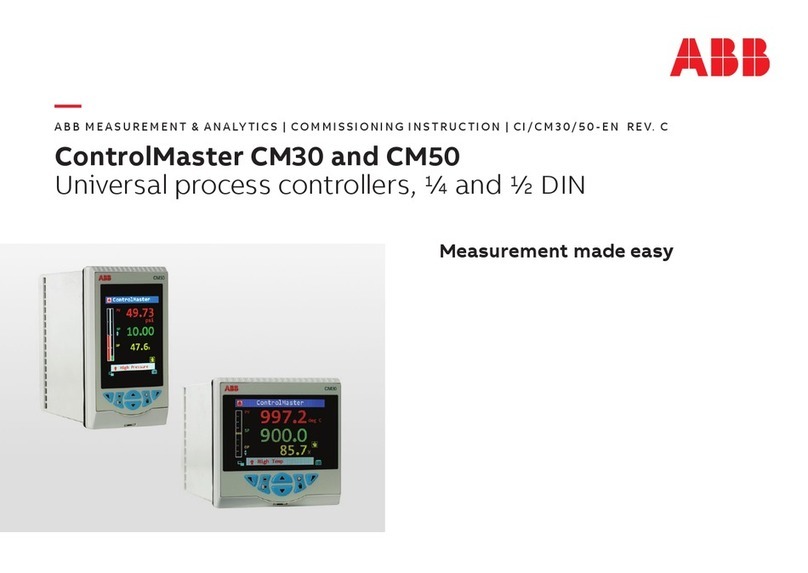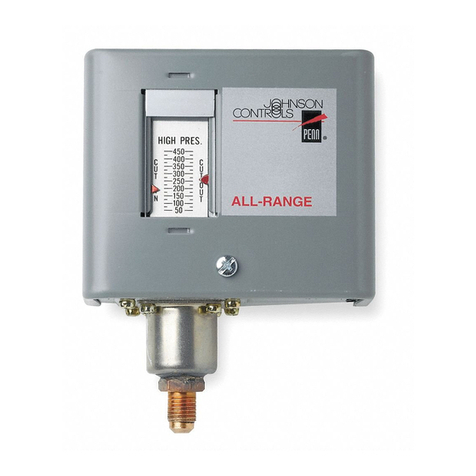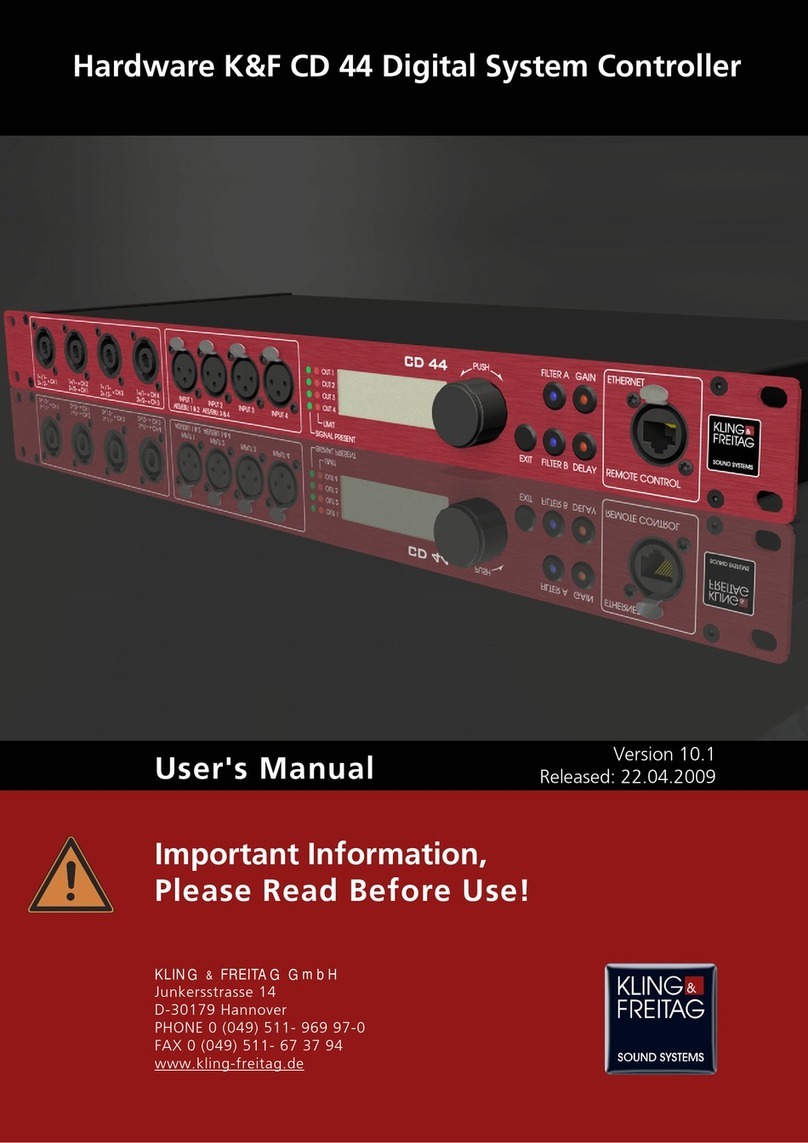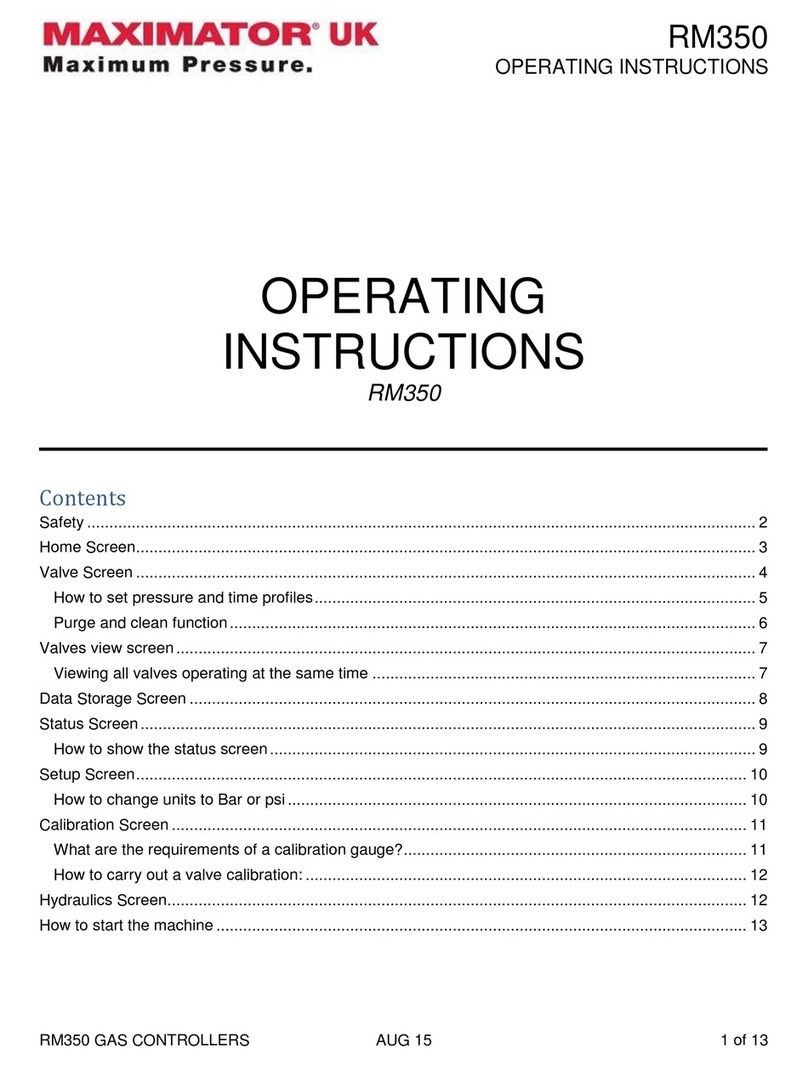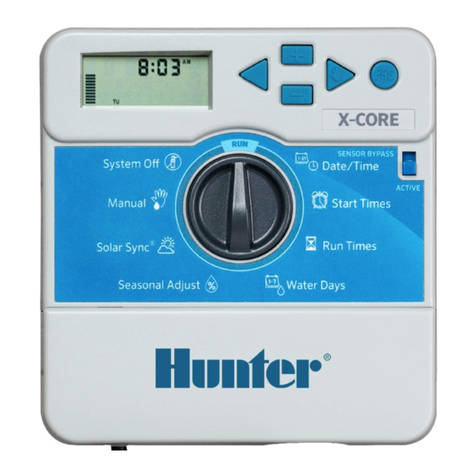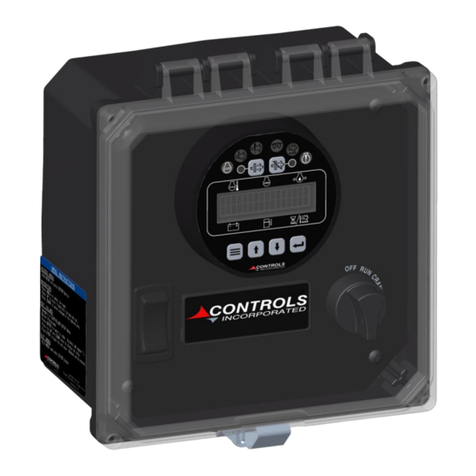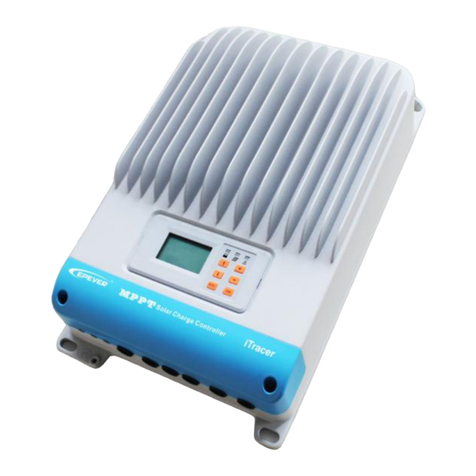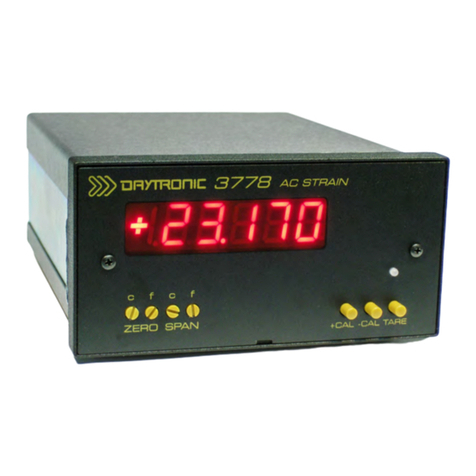EtherCAT TMCM-1310 Use and care manual

MODULE FOR STEPPER MOTORS MODULE
TRINAMIC Motion Control GmbH & Co. KG
Hamburg, Germany
www.trinamic.com
Firmware Version V1.11
TMCL™ FIRMWARE MANUAL
+ + TMCM-1310
+ +
1-Axis Stepper
Closed Loop Controller / Driver
3A RMS / 48 V
ABN and SSI Encoder Input
18 GPIOs
USB, EtherCAT®

TMCM-1310 TMCL Firmware V1.11 Manual (Rev. 1.16 / 2014-MAR-19) 2
www.trinamic.com
Table of Contents
1Features........................................................................................................................................................................... 4
2Overview......................................................................................................................................................................... 6
3Communication via EtherCAT ................................................................................................................................... 7
3.1 SyncManager ......................................................................................................................................................... 7
3.1.1 Buffered Mode................................................................................................................................................ 7
3.1.2 Mailbox Mode, used for TMCL-Applications........................................................................................... 8
3.2 EtherCAT Slave State Machine ......................................................................................................................... 9
3.3 EtherCAT Firmware Update............................................................................................................................. 11
3.4 Process Data ....................................................................................................................................................... 11
3.5 TMCL Mailbox ...................................................................................................................................................... 13
3.6 Binary Command Format ................................................................................................................................ 13
3.7 Status Codes ....................................................................................................................................................... 13
4Operation with USB Interface ................................................................................................................................ 14
4.1 Binary Command Format for USB Interface.............................................................................................. 14
4.2 Reply Format....................................................................................................................................................... 15
4.2.1 Status Codes ................................................................................................................................................. 15
4.3 Standalone Applications.................................................................................................................................. 15
5The ASCII Interface ................................................................................................................................................... 16
5.1 Format of the Command Line ....................................................................................................................... 16
5.2 Format of a Reply.............................................................................................................................................. 16
5.3 Commands Used in ASCII Mode................................................................................................................... 16
5.4 Configuring the ASCII Interface.................................................................................................................... 17
6TMCL Commands ........................................................................................................................................................ 18
6.1 Motion Commands............................................................................................................................................ 18
6.2 Parameter Commands...................................................................................................................................... 18
6.3 Control Commands ........................................................................................................................................... 18
6.4 I/O Port Commands .......................................................................................................................................... 18
6.5 Calculation Commands .................................................................................................................................... 19
6.6 Interrupt Commands ........................................................................................................................................ 19
6.6.1 Interrupt Types ............................................................................................................................................ 19
6.6.2 Interrupt Processing................................................................................................................................... 19
6.6.3 Interrupt Vectors ......................................................................................................................................... 20
6.6.4 Further Configuration of Interrupts....................................................................................................... 20
6.6.5 Using Interrupts in TMCL .......................................................................................................................... 20
6.7 ASCII Commands............................................................................................................................................... 21
6.8 Commands........................................................................................................................................................... 22
6.8.1 ROR (rotate right) ........................................................................................................................................ 22
6.8.2 ROL (rotate left) ........................................................................................................................................... 23
6.8.3 MST (motor stop)......................................................................................................................................... 24
6.8.4 MVP (move to position) ............................................................................................................................ 25
6.8.5 SAP (set axis parameter) ........................................................................................................................... 27
6.8.6 GAP (get axis parameter) .......................................................................................................................... 28
6.8.7 STAP (store axis parameter) ..................................................................................................................... 29
6.8.8 RSAP (restore axis parameter) ................................................................................................................. 30
6.8.9 SGP (set global parameter) ...................................................................................................................... 31
6.8.10 GGP (get global parameter)...................................................................................................................... 32
6.8.11 STGP (store global parameter) ................................................................................................................ 33
6.8.12 RSGP (restore global parameter) ............................................................................................................ 34
6.8.13 RFS (reference search)................................................................................................................................ 35
6.8.14 SIO (set input / output)............................................................................................................................. 36
6.8.15 GIO (get input /output) ............................................................................................................................. 38
6.8.16 CALC (calculate)............................................................................................................................................ 41
6.8.17 COMP (compare)........................................................................................................................................... 42
6.8.18 JC (jump conditional) ................................................................................................................................. 43
6.8.19 JA (jump always) ......................................................................................................................................... 44
6.8.20 CSUB (call subroutine) ............................................................................................................................... 45

TMCM-1310 TMCL Firmware V1.11 Manual (Rev. 1.16 / 2014-MAR-19) 3
www.trinamic.com
6.8.21 RSUB (return from subroutine)................................................................................................................ 46
6.8.22 WAIT (wait for an event to occur)......................................................................................................... 47
6.8.23 STOP (stop TMCL program execution) ................................................................................................... 48
6.8.24 SCO (set coordinate)................................................................................................................................... 49
6.8.25 GCO (get coordinate).................................................................................................................................. 50
6.8.26 CCO (capture coordinate) .......................................................................................................................... 51
6.8.27 ACO (accu to coordinate) .......................................................................................................................... 52
6.8.28 CALCX (calculate using the X register) .................................................................................................. 53
6.8.29 AAP (accumulator to axis parameter).................................................................................................... 54
6.8.30 AGP (accumulator to global parameter) ............................................................................................... 55
6.8.31 CLE (clear error flags) ................................................................................................................................. 56
6.8.32 VECT (set interrupt vector)........................................................................................................................ 57
6.8.33 EI (enable interrupt) ................................................................................................................................... 58
6.8.34 DI (disable interrupt).................................................................................................................................. 59
6.8.35 RETI (return from interrupt) ..................................................................................................................... 60
6.8.36 Customer Specific TMCL Command Extension (user function)....................................................... 61
6.8.37 Request Target Position Reached Event ............................................................................................... 62
6.8.38 BIN (return to binary mode).................................................................................................................... 62
6.8.39 TMCL Control Functions............................................................................................................................. 63
7Axis Parameters .......................................................................................................................................................... 64
7.1 Velocity Calculation........................................................................................................................................... 76
8stallGuard2 Related Parameters ............................................................................................................................. 77
9Closed-Loop Operation Related Axis Parameter................................................................................................ 78
9.1 General Closed Loop Axis Parameters ........................................................................................................ 78
9.2 General Structure of the Closed Loop System ......................................................................................... 79
9.3 Setting Encoder Resolution and Motor Resolution ................................................................................. 80
9.4 Positioning Mode .............................................................................................................................................. 81
9.5 Position Maintenance and Standstill Mode ............................................................................................... 84
9.6 Velocity Mode ..................................................................................................................................................... 86
9.7 Torque Mode....................................................................................................................................................... 87
9.8 Current Regulation ............................................................................................................................................ 88
9.9 Field Weakening ................................................................................................................................................ 92
9.10 Status and Feedback Information ................................................................................................................ 93
9.11 Example Programs: Closed Loop Operation .............................................................................................. 94
9.11.1 Example Program 1..................................................................................................................................... 94
9.11.2 Example Program 2..................................................................................................................................... 95
10 Reference Search ........................................................................................................................................................ 96
10.1.1 Reference Search Modes (Axis Parameter 193)................................................................................... 97
11 Global Parameters...................................................................................................................................................... 99
11.1 Bank 0 ................................................................................................................................................................... 99
11.2 Bank 1 .................................................................................................................................................................100
11.3 Bank 2 .................................................................................................................................................................101
11.4 Bank 3 .................................................................................................................................................................101
12 TMCL Programming Techniques and Structure ...............................................................................................102
12.1 Initialization ......................................................................................................................................................102
12.2 Main Loop.......................................................................................................................................................... 102
12.3 Using Symbolic Constants ............................................................................................................................102
12.4 Using Variables ................................................................................................................................................103
12.5 Using Subroutines........................................................................................................................................... 103
12.6 Mixing Direct Mode and Standalone Mode..............................................................................................104
13 Life Support Policy...................................................................................................................................................105
14 Revision History........................................................................................................................................................ 106
14.1 Firmware Revision ..........................................................................................................................................106
14.2 Document Revision .........................................................................................................................................106
15 References ..................................................................................................................................................................107

TMCM-1310 TMCL Firmware V1.11 Manual (Rev. 1.16 / 2014-MAR-19) 4
www.trinamic.com
1Features
The TMCM-1310 is a single axis stepper motor controller/driver standalone board with closed loop support.
For communication an USB interface and EtherCAT®* are provided. The module supports motor currents up
to 3A RMS and supply voltages up to 48V nominal. The module offers inputs for one incremental a/b/n
(TTL, open-collector and differential inputs) or absolute SSI encoders (selectable in software). There are
dedicated stop switch inputs, 8 general purpose inputs, and 8 general purpose outputs.
MAIN CHARACTERISTICS
Bipolar stepper motor driver
-Up to 256 microsteps per full step
-High-efficient operation, low power dissipation
-Dynamic current control
-Integrated protection: overtemperature and undervoltage
-stallGuard2™ feature for stall detection (for open loop operation)
Encoder
-Encoder input for incremental a/b/n (TTL, open-collector and differential inputs) and absolute SSI
encoders (selectable in software)
Interfaces
-USB 2.0 full-speed (12Mbit/s) communication interface (mini-USB connector)
-EtherCAT LINK IN and LINK OUT (RJ45)
-Dedicated STOP_L / STOP_R inputs
-Up to 8 multi-purpose inputs (+24V compatible, incl. 2 dedicated analog inputs)
-Up to 8 multi-purpose outputs (open-drain, incl. 2 outputs for currents up to 1A)
Software
-TMCL™ remote (direct mode) and standalone operation with memory for up to 1024 TMCL commands
-Closed-loop support
-Fully supported by TMCL-IDE (PC based integrated development environment)
Electrical data
-Supply voltage: +12V… +48V DC
-Motor current: up to 3A RMS (programmable)
Mechanical data
-Board size: 110mm x 110mm, height 26.3mm
Please refer to separate TMCM-1310 Hardware Manual for additional information.
* EtherCAT® is registered trademark and patented technology, licensed by Beckhoff Automation GmbH,
Germany.

TMCM-1310 TMCL Firmware V1.11 Manual (Rev. 1.16 / 2014-MAR-19) 5
www.trinamic.com
TRINAMIC FEATURES –CLOSED LOOP MODE
The TMCM-1310 is mainly designed to run 2-phase stepper motors in closed loop mode. It offers an
automatic motor load adaption in positioning mode, velocity mode, and torque mode, which is based on
encoder feedback and closed loop control software for analysis, error detection and error correction.
The closed loop mode operation combines the advantages of a stepper driver system with the benefits of
a servo drive. Thus, the TMCM-1310 is able to satisfy ambitious requirements in reliability and precision
and can be used in several industrial demanding applications.
Benefits of Stepper Drive
High torque without gearing
No feedback loop oscillations
High precision
Precise velocity control
Benefits of Servo Drive
Reaction to any impact
No position loss
Torque control
TMCM-1310
Figure 1.1 TMCM-1310 characteristics in closed loop mode
THE TRINAMIC CLOSED LOOP MODE OPERATION
-prevents the motor from stall and step loss caused by too high load or high velocity.
-adapts the current amplitude to each motor load which is within the ranges predetermined by motor
and controller/driver board characteristics.
-achieves a higher torque output than in open loop mode.
-guarantees a precise and fast positioning.
-enables velocity and positioning error compensation.
Using the TMCM-1310, energy will be saved and the motor will be kept cool.

TMCM-1310 TMCL Firmware V1.11 Manual (Rev. 1.16 / 2014-MAR-19) 6
www.trinamic.com
2Overview
The software running on the microprocessor of the TMCM-1310 consists of two parts, a boot loader and
the firmware itself. Whereas the boot loader is installed during production and testing at TRINAMIC and
remains untouched throughout the whole lifetime, the firmware can be updated by the user. New versions
can be downloaded free of charge from the TRINAMIC website (http://www.trinamic.com).
The TMCM-1310 can be used as an EtherCAT slave device. The whole communication with the EtherCAT
master follows a strict master-slave-relationship. Via the TMCL mailbox motor parameters are written
and/or read using TRINAMICs TMCL protocol.
The firmware of this module is related to the standard TMCL firmware with a special range of values. The
TRINAMIC Motion Control Language [TMCL] provides a set of structured motion control commands. Every
motion control command can be given by a host computer or can be stored in an EEPROM on the module
to form programs that run standalone. For this purpose there are not only motion control commands but
also commands to control the program structure (like conditional jumps, compare and calculating).
Every command has a binary representation and a mnemonic. The binary format is used to send
commands from the host to a module in direct mode, whereas the mnemonic format is used for easy
usage of the commands when developing standalone TMCL applications using the TMCL-IDE (IDE means
Integrated Development Environment).
There is also a set of configuration variables for the axis and for global parameters which allow individual
configuration of nearly every function of the module. This manual gives a detailed description of all TMCL
commands and their usage.

TMCM-1310 TMCL Firmware V1.11 Manual (Rev. 1.16 / 2014-MAR-19) 7
www.trinamic.com
3Communication via EtherCAT
3.1 SyncManager
The SyncManager enables consistent and secure data exchange between the EtherCAT master and the local
application, and it generates interrupts to inform both sides of changes. The SyncManager is configured by
the EtherCAT master. The communication direction is configurable, as well as the communication mode
(buffered mode and mailbox mode). The SyncManager uses a buffer located in the memory area for
exchanging data. Access to this buffer is controlled by the hardware of the SyncManager.
A buffer has to be accessed beginning with the start address, otherwise the access is denied. After
accessing the start address, the whole buffer can be accessed, even the start address again, either as a
whole or in several strokes. A buffer access finishes by accessing the end address, the buffer state changes
afterwards. The end address cannot be accessed twice inside a frame. Two communication modes are
supported by SyncManagers, the buffered mode and the mailbox mode.
3.1.1 Buffered Mode
The buffered mode allows both sides, EtherCAT master and local application, to access the communication
buffer at any time. The consumer gets always the latest consistent buffer which was written by the
producer, and the producer can always update the content of the buffer. The buffered mode is used for
cyclic process data.
Data transfer between EtherCAT master (PC etc.) und slave (TMCM-1310) is done using the dual port
memory of the ET1100 EtherCAT-IC on the slave. The buffered mode allows writing and reading data
simultaneously without interference. If the buffer is written faster than it is read out, old data will be
dropped. The buffered mode is also known as 3-buffermode. One buffer of the three buffers is allocated to
the producer (for writing), one buffer to the consumer (for reading), and the third buffer keeps the last
consistently written data of the producer.
0x1000
-
0x10FF
0x1100
-
0x11FF
0x1200
-
0x12FF
0x1300
Buffer 0
(visible)
Buffer 1
(invisible, shall not be used)
Buffer 2
(invisible, shall not be used)
Next usable RAM space
All buffers are
controlled by the
SyncManager. Only
buffer 0 is configured
by the SyncManager
and addressed by
ECAT and μController.
Figure 3.1 SyncManager buffer allocation
As an example, Figure 3.1 demonstrates a configuration with start address 0x1000 and length 0x100. The
other buffers shall not be read or written. Access to the buffer is always directed to addresses in the range
of buffer 0.

TMCM-1310 TMCL Firmware V1.11 Manual (Rev. 1.16 / 2014-MAR-19) 8
www.trinamic.com
ECAT NEXT PDI µControllerMaster
Exchange buffer
(if frame is o.k.)
Load next buffer
if new data are
available
Load next buffer
if new data are
available
Exchange buffer
Read begin
Read end
Read begin
Read end
Write begin
Write end
Write begin
Write end
Figure 3.2 SyncManager buffered mode interaction
3.1.2 Mailbox Mode, used for TMCL-Applications
The mailbox mode implements a handshake mechanism for data exchange, so that no data will be lost.
Each side, EtherCAT master or local application will get access to the buffer only after the other side has
finished its access. The mailbox mode only allows alternating reading and writing. This assures that all
data from the producer will reach the consumer. The mailbox mode uses just one buffer of the configured
size. At first, after initialization/activation, the buffer (mailbox, MBX) is writeable. Once it is written
completely, write access is blocked, and the buffer can be read out by the other side. After it was
completely read out, it can be written again. The time it takes to read or write the mailbox does not
matter. The mailbox mode is used for the application layer protocol.
Via the mailbox motor-parameters of the TMCM-1310 can be written/read using the TMCL protocol.
mailbox full
mailbox empty
mailbox full
mailbox empty
µControllerMaster
Read
Read w. failure
(mailbox empty)
Write mailbox
Read mailbox
Write
Write w. failure
(mailbox full)
Write
Write w. failure
(mailbox full)
Read
Read w. failure
(mailbox empty)
Figure 3.3 SyncManager mailbox interaction

TMCM-1310 TMCL Firmware V1.11 Manual (Rev. 1.16 / 2014-MAR-19) 9
www.trinamic.com
3.2 EtherCAT Slave State Machine
The EtherCAT slave state machine has four states, which are shown in Figure 3.4. After power ON the slave
state machine is in the Init state. In this situation mailbox and process data communication is impossible.
The EtherCAT master initializes the SyncManager channels 0 and 1 for the communication via mailbox.
While changeover from Init state to Pre-Operational state the EtherCAT slave checks the correct
initialization of the mailbox. Afterwards mailbox communication is possible. Now, in the Pre-Operational
state the master initializes the SyncManager channels for the process data and the FMMU channels.
Furthermore adjustments are sent, which differ from the default values.
While changeover from Pre-Operational state to Safe-Operational state the EtherCAT slave checks the
correct initialization of the SyncManager channels for the process data as well as the adjustments for the
Distributed Clocks. Before accepting the change of state, the EtherCAT slave copies actual input data into
the accordant DP-RAM array of the EtherCAT slave controller. In the Safe-Operational state mailbox and
process data communication are possible, but the slave holds its outputs in a safe situation and actualizes
the input data periodically.
Before the EtherCAT slave changes the state to Operational it has to transfer valid output data. In the
Operational state the EtherCAT slave copies the output data from the EtherCAT master to its outputs.
Process data communication and mailbox communication are possible now.
The Bootstrap state is only used for updating the firmware. This state is reachable form the Init state.
During Bootstrap state mailbox communication is available over File-Access over EtherCAT. Beyond this
mailbox communication or process data communication is not possible.
Pre-Operational
Operational
Init
Safe-Operational
EtherCAT™ Slave State Machine
Bootstrap (optional)
Figure 3.4 EtherCAT™ slave state machine

TMCM-1310 TMCL Firmware V1.11 Manual (Rev. 1.16 / 2014-MAR-19) 10
www.trinamic.com
State / state change
Services
Init
-No communication on application layer
-Master has access to the DL-information registers
Init to Pre-Operational
-Master configures registers, at least:
•DL address register
•SyncManager channels for mailbox
communication
-Master initializes Distributed Clock synchronization
-Master requests Pre-Operational state
•Master sets AL control register
-Wait for AL status register confirmation
Pre-Operational
-Mailbox communication on the application layer
-No process data communication
Pre-Operational to Safe-Operational
-Master configures parameters using the mailbox:
•e.g., process data mapping
-Master configures DL Register:
•SyncManager channels for process data
communication
•FMMU channels
-Master requests Safe-Operational state
-Wait for AL Status register confirmation
Safe-Operational
-Mailbox communication on the application layer
-Process data communication, but only inputs are
evaluated. Outputs remain in safe state
Safe-Operational to Operational
-Master sends valid outputs
-Master requests Operational state (AL Control/Status)
-Wait for AL Status register confirmation
Operational
-Inputs and outputs are valid
Bootstrap
Recommended if firmware updates are necessary
-State changes only from and to Init
-No Process Data communication
-Mailbox communication on application layer, only
FoE protocol available (possibly limited file range)
THREE LEDS DISPLAY THE ACTUAL ACTIVITY:
Green LED
Description
EtherCAT0
LINK OUT state
OFF
No link.
blinking
Link and activity.
single flash
Link without activity.
EtherCAT
LINK IN state
OFF
No link.
blinking
Link and activity.
single flash
Link without activity.
EtherCAT
RUN state
OFF
The device is in state INIT.
blinking
The device is in state PRE-OPERATIONAL.
single flash
The device is in state SAFE-OPERATONAL.
ON
The device is in state OPERATIONAL.
flickering (fast)
The device is in state BOOTSTRAP.

TMCM-1310 TMCL Firmware V1.11 Manual (Rev. 1.16 / 2014-MAR-19) 11
www.trinamic.com
3.3 EtherCAT Firmware Update
For firmware updates the EtherCAT state machine of the slave has to be switched to Bootstrap state. The
file access over EtherCAT protocol (FoE) is used.
THE TWO MAILBOXES FOR DATA TRANSFERS HAVE THE FOLLOWING PARAMETERS:
-Data output buffer: Start-address: 4096, length: 268 byte
-Data input buffer: Start-address: 4364, length: 40 byte
3.4 Process Data
In standard configuration for data transfer the following buffers are used (slave view):
DATA OUTPUT BUFFER /ETHERCAT MASTER -> SLAVE DATA TRANSFER
Data output buffer: Start-address: 4096(0x1000), length: first 8 bytes
Start address
End address
Data type
Data value / contents
0x1000
0x1003
UNSIGNED32
Controller Mode
Bit
Description
0
No operation
1
Position mode
2
Velocity mode
3 3
Torque mode
0x1004
0x1007
SIGNED32
Value
(position / velocity / current)

TMCM-1310 TMCL Firmware V1.11 Manual (Rev. 1.16 / 2014-MAR-19) 12
www.trinamic.com
DATA INPUT BUFFER /ETHERCAT SLAVE -> MASTER DATA TRANSFER
Data input buffer: Start-address: 4216(0x1078), length: first 44 bytes
Start address
End address
Data type
Data value / contents
0x1078
0x107B
SIGNED32
Target Position
Command for read out: GAP 0
0x107C
0x107F
SIGNED32
Actual position
Command for read out: GAP 1
0x1080
0x1083
SIGNED32
Virtual actual position
Command for read out: GAP 233.
0x1084
0x1087
SIGNED32
Encoder Position
Command for read out: GAP 209
0x1088
0x108B
SIGNED32
Target velocity
Command for read out: GAP 2
0x108C
0x108F
SIGNED32
Actual velocity
Command for read out: GAP 3
0x1090
0x1093
SIGNED32
Measured velocity
Command for read out: GAP 131
0x1094
0x1097
UNSIGNED32
Status word
Command for read out: GAP 18)
0x1098
0x109B
UNSIGNED32
Error flags
Bit
Description
0
Target reached
1
Velocity reached
2
Closed loop
3 3
Position mode
4
Velocity mode
5
Torque mode
6
Home switch
7
Left stop switch
8
Right stop switch
9
Undervoltage
10
Overvoltage
11
Overtemperature
0x109C
0x109F
SIGNED32
Scaler
Command for read out: GAP123
0x1100
0x1103
SIGNED32
Delta / torque
Command for read out: GAP 14
0x1104
0x1107
SIGNED32
Gamma
Command for read out: 230
All numbers are stored in little endian format. (least significant byte is stored at the lowest address)

TMCM-1310 TMCL Firmware V1.11 Manual (Rev. 1.16 / 2014-MAR-19) 13
www.trinamic.com
3.5 TMCL Mailbox
The TMCM-1310 slave module supports the TMCL protocol in direct mode. The communication follows a
strict master-slave-relationship. Via the TMCL mailbox motor-parameters can be read and/or written.
3.6 Binary Command Format
Every command has a mnemonic and a binary representation. When commands are sent from a host to a
module, the binary format has to be used. Every command consists of a one-byte command field, a one-
byte type field, a one-byte motor/bank field and a four-byte value field. So the binary representation of a
command always has seven bytes.
TRANSMIT AN 8-BYTE COMMAND:
Bytes
Meaning
1
Module address
1
Command number
1
Type number
1
Motor or Bank number
4
Value (MSB first!)
Every time a command has been sent to a module, the module sends a reply.
RECEIVE AN 8-BYTE REPLY:
Bytes
Meaning
1
Reply address
1
Module address
1
Status (e.g. 100 means no error)
1
Command number
4
Value (MSB first!)
3.7 Status Codes
The reply contains a status code.
THE STATUS CODE CAN HAVE ONE OF THE FOLLOWING VALUES:
Code
Meaning
100
Successfully executed, no error
2
Invalid command
3
Wrong type
4
Invalid value
5
Configuration EEPROM locked
6
Command not available
8
Parameter is password protected

TMCM-1310 TMCL Firmware V1.11 Manual (Rev. 1.16 / 2014-MAR-19) 14
www.trinamic.com
4Operation with USB Interface
In direct mode and most cases the TMCL communication over USB follows a strict master/slave
relationship. That is, a host computer (e.g. PC/PLC) acting as the interface bus master will send a command
to the TMCL-1310. The TMCL interpreter on the module will then interpret this command, do the
initialization of the motion controller, read inputs and write outputs or whatever is necessary according to
the specified command. As soon as this step has been done, the module will send a reply back over USB
to the bus master. Only then should the master transfer the next command.
4.1 Binary Command Format for USB Interface
When commands are sent from a host to a module, the binary format has to be used. Every command
consists of a one-byte command field, a one-byte type field, a one-byte motor/bank field and a four-byte
value field. So the binary representation of a command always has seven bytes. When a command is to be
sent via USB interface, it has to be enclosed by an address byte at the beginning and a checksum byte at
the end. In this case it consists of nine bytes.
THE BINARY COMMAND FORMAT FOR USB IS AS FOLLOWS:
Bytes
Meaning
1
Module address
1
Command number
1
Type number
1
Motor or Bank number
4
Value (MSB first!)
1
Checksum
The checksum is calculated by adding up all the other bytes using an 8-bit addition.
CHECKSUM CALCULATION
As mentioned above, the checksum is calculated by adding up all bytes (including the module address
byte) using 8-bit addition. Here are two examples to show how to do this:
in C:
unsigned char i, Checksum;
unsigned char Command[9];
//Set the “Command” array to the desired command
Checksum = Command[0];
for(i=1; i<8; i++)
Checksum+=Command[i];
Command[8]=Checksum; //insert checksum as last byte of the command
//Now, send it to the module

TMCM-1310 TMCL Firmware V1.11 Manual (Rev. 1.16 / 2014-MAR-19) 15
www.trinamic.com
4.2 Reply Format
Every time a command has been sent to a module, the module sends a reply.
THE REPLY FORMAT FOR USB IS AS FOLLOWS:
Bytes
Meaning
1
Reply address
1
Module address
1
Status (e.g. 100 means “no error”)
1
Command number
4
Value (MSB first!)
1
Checksum
The checksum is also calculated by adding up all the other bytes using an 8-bit addition. Do not send the
next command before you have received the reply!
4.2.1 Status Codes
The reply contains a status code.
The status code can have one of the following values:
Code
Meaning
100
Successfully executed, no error
101
Command loaded into TMCL
program EEPROM
1
Wrong checksum
2
Invalid command
3
Wrong type
4
Invalid value
5
Configuration EEPROM locked
6
Command not available
4.3 Standalone Applications
The module is equipped with an EEPROM for storing TMCL applications. You can use TMCL-IDE for
developing standalone TMCL applications. You can load them down into the EEPROM and then it will run
on the module. The TMCL-IDE contains an editor and the TMCL assembler where the commands can be
entered using their mnemonic format. They will be assembled automatically into their binary
representations. Afterwards this code can be downloaded into the module to be executed there.

TMCM-1310 TMCL Firmware V1.11 Manual (Rev. 1.16 / 2014-MAR-19) 16
www.trinamic.com
5The ASCII Interface
There is also an ASCII interface that can be used to communicate with the module and to send some
commands as text strings. The ASCII format can be used with the USB interface, only.
PROCEED AS FOLLOWS
-The ASCII command line interface is entered by sending the binary command 139 (enter ASCII mode).
-Afterwards the commands are entered as in the TMCL-IDE. Please note that only those commands,
which can be used in direct mode, also can be entered in ASCII mode.
-For leaving the ASCII mode and re-entering the binary mode enter the command BIN.
5.1 Format of the Command Line
As the first character, the address character has to be sent. The address character is Awhen the module
address is 1, Bfor modules with address 2 and so on. After the address character there may be spaces
(but this is not necessary). Then, send the command with its parameters. At the end of a command line a
<CR> character has to be sent.
EXAMPLES FOR VALID COMMAND LINES
AMVP ABS, 1, 50000
A MVP ABS, 1, 50000
AROL 2, 500
A MST 1
ABIN
These command lines would address the module with address 1. To address e.g. module 3, use address
character Cinstead of A. The last command line shown above will make the module return to binary
mode.
5.2 Format of a Reply
After executing the command the module sends back a reply in ASCII format. The reply consists of:
-the address character of the host (host address that can be set in the module)
-the address character of the module
-the status code as a decimal number
-the return value of the command as a decimal number
-a <CR> character
So, after sending AGAP 0, 1 the reply would be BA 100 –5000 if the actual position of axis 1 is –5000,
the host address is set to 2 and the module address is 1. The value 100 is the status code 100 that means
command successfully executed.
5.3 Commands Used in ASCII Mode
The following commands can be used in ASCII mode: ROL, ROR, MST, MVP, SAP, GAP, STAP, RSAP, SGP,
GGP, STGP, RSGP, RFS, SIO, GIO, SCO, GCO, CCO, UF0, UF1, UF2, UF3, UF4, UF5, UF6, and UF7.
SPECIAL COMMANDS WHICH ARE ONLY AVAILABLE IN ASCII MODE
-BIN: This command quits ASCII mode and returns to binary TMCL mode.
-RUN: This command can be used to start a TMCL program in memory.
-STOP: Stops a running TMCL application.

TMCM-1310 TMCL Firmware V1.11 Manual (Rev. 1.16 / 2014-MAR-19) 17
www.trinamic.com
5.4 Configuring the ASCII Interface
The module can be configured so that it starts up either in binary mode or in ASCII mode. Global
parameter 67 is used for this purpose (please see also chapter 11.1).
Bit 0 determines the startup mode: if this bit is set, the module starts up in ASCII mode, else it will start
up in binary mode (default).
Bit 4 and Bit 5 determine how the characters that are entered are echoed back. Normally, both bits are set
to zero. In this case every character that is entered is echoed back when the module is addressed.
Character can also be erased using the backspace character (press the backspace key in a terminal
program).
When bit 4 is set and bit 5 is clear the characters that are entered are not echoed back immediately but
the entire line will be echoed back after the <CR> character has been sent.
When bit 5 is set and bit 4 is clear there will be no echo, only the reply will be sent. This may be useful in
RS485 systems.

TMCM-1310 TMCL Firmware V1.11 Manual (Rev. 1.16 / 2014-MAR-19) 18
www.trinamic.com
6TMCL Commands
6.1 Motion Commands
These commands control the motion of the motor. They are the most important commands and can be
used in direct mode or in standalone mode.
Mnemonic
Command number
Meaning
ROL
2
Rotate left
ROR
1
Rotate right
MVP
4
Move to position
MST
3
Motor stop
RFS
13
Reference search
SCO
30
Store coordinate
CCO
32
Capture coordinate
GCO
31
Get coordinate
6.2 Parameter Commands
These commands are used to set, read and store axis parameters or global parameters. Axis parameters
can be set independently for the axis, whereas global parameters control the behavior of the module itself.
These commands can also be used in direct mode and in standalone mode.
6.3 Control Commands
These commands are used to control the program flow (loops, conditions, jumps etc.). It does not make
sense to use them in direct mode. They are intended for standalone mode only.
Mnemonic
Command number
Meaning
JA
22
Jump always
JC
21
Jump conditional
COMP
20
Compare accumulator with constant value
CSUB
23
Call subroutine
RSUB
24
Return from subroutine
WAIT
27
Wait for a specified event
STOP
28
End of a TMCL program
6.4 I/O Port Commands
These commands control the external I/O ports and can be used in direct mode and in standalone mode.
Mnemonic
Command number
Meaning
SIO
14
Set output
GIO
15
Get input
Mnemonic
Command number
Meaning
SAP
5
Set axis parameter
GAP
6
Get axis parameter
STAP
7
Store axis parameter into EEPROM
RSAP
8
Restore axis parameter from EEPROM
SGP
9
Set global parameter
GGP
10
Get global parameter
STGP
11
Store global parameter into EEPROM
RSGP
12
Restore global parameter from EEPROM

TMCM-1310 TMCL Firmware V1.11 Manual (Rev. 1.16 / 2014-MAR-19) 19
www.trinamic.com
6.5 Calculation Commands
These commands are intended to be used for calculations within TMCL applications. Although they could
also be used in direct mode it does not make much sense to do so.
Mnemonic
Command number
Meaning
CALC
19
Calculate using the accumulator and a constant value
CALCX
33
Calculate using the accumulator and the X register
AAP
34
Copy accumulator to an axis parameter
AGP
35
Copy accumulator to a global parameter
ACO
39
Copy accu to coordinate
For calculating purposes there is an accumulator (or accu or A register) and an X register. When executed
in a TMCL program (in standalone mode), all TMCL commands that read a value store the result in the
accumulator. The X register can be used as an additional memory when doing calculations. It can be
loaded from the accumulator.
When a command that reads a value is executed in direct mode the accumulator will not be affected. This
means that while a TMCL program is running on the module (standalone mode), a host can still send
commands like GAP and GGP to the module (e.g. to query the actual position of the motor) without
affecting the flow of the TMCL program running on the module.
6.6 Interrupt Commands
Due to some customer requests, interrupt processing has been introduced in the TMCL firmware for ARM
based modules.
Mnemonic
Command number
Meaning
EI
25
Enable interrupt
DI
26
Disable interrupt
VECT
37
Set interrupt vector
RETI
38
Return from interrupt
6.6.1 Interrupt Types
There are many different interrupts in TMCL, like timer interrupts, stop switch interrupts, position reached
interrupts, and input pin change interrupts. Each of these interrupts has its own interrupt vector. Each
interrupt vector is identified by its interrupt number. Please use the TMCL included file Interrupts.inc for
symbolic constants of the interrupt numbers.
6.6.2 Interrupt Processing
When an interrupt occurs and this interrupt is enabled and a valid interrupt vector has been defined for
that interrupt, the normal TMCL program flow will be interrupted and the interrupt handling routine will
be called. Before an interrupt handling routine gets called, the context of the normal program will be
saved automatically (i.e. accumulator register, X register, TMCL flags).
There is no interrupt nesting, i.e. all other interrupts are disabled while an interrupt handling routine is
being executed.
On return from an interrupt handling routine, the context of the normal program will automatically be
restored and the execution of the normal program will be continued.

TMCM-1310 TMCL Firmware V1.11 Manual (Rev. 1.16 / 2014-MAR-19) 20
www.trinamic.com
6.6.3 Interrupt Vectors
The following table shows all interrupt vectors that can be used.
Interrupt number
Interrupt type
0
Timer 0
1
Timer 1
2
Timer 2
3
Target position reached
15
stallGuard2
21
Deviation
27
Left stop switch
28
Right stop switch
39
Input change 0
40
Input change 1
41
Input change 2
42
Input change 3
43
Input change 4
44
Input change 5
45
Input change 6
46
Input change 7
255
Global interrupts
6.6.4 Further Configuration of Interrupts
Some interrupts need further configuration (e.g. the timer interval of a timer interrupt). This can be done
using SGP commands with parameter bank 3 (SGP <type>, 3, <value>). Please refer to the SGP command
(paragraph 6.8.9) for further information about that.
6.6.5 Using Interrupts in TMCL
To use an interrupt the following things have to be done:
-Define an interrupt handling routine using the VECT command.
-If necessary, configure the interrupt using an SGP <type>, 3, <value> command.
-Enable the interrupt using an EI <interrupt> command.
-Globally enable interrupts using an EI 255 command.
-An interrupt handling routine must always end with a RETI command
The following example shows the use of a timer interrupt:
VECT 0, Timer0Irq //define the interrupt vector
SGP 0, 3, 1000 //configure the interrupt: set its period to 1000ms
EI 0 //enable this interrupt
EI 255 //globally switch on interrupt processing
//Main program: toggles output 3, using a WAIT command for the delay
Loop:
SIO 3, 2, 1
WAIT TICKS, 0, 50
SIO 3, 2, 0
WAIT TICKS, 0, 50
JA Loop
//Here is the interrupt handling routine
Timer0Irq:
GIO 0, 2 //check if OUT0 is high
JC NZ, Out0Off //jump if not
SIO 0, 2, 1 //switch OUT0 high
RETI //end of interrupt
Out0Off:
SIO 0, 2, 0 //switch OUT0 low
RETI //end of interrupt
This manual suits for next models
1
Table of contents
Popular Controllers manuals by other brands
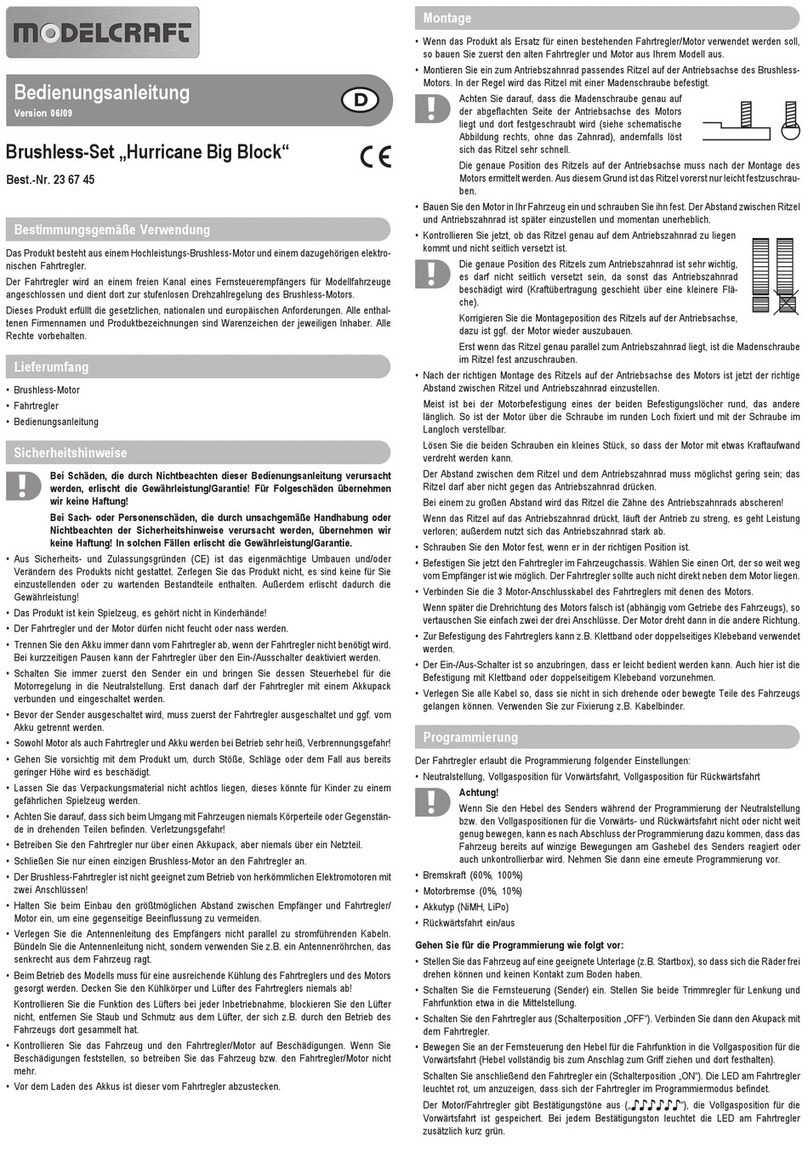
ModelCraft
ModelCraft Hurricane Big Block operating instructions

Tews Technologies
Tews Technologies TPMC682-10 user manual

Distech Controls
Distech Controls DA-020S024PX installation instructions
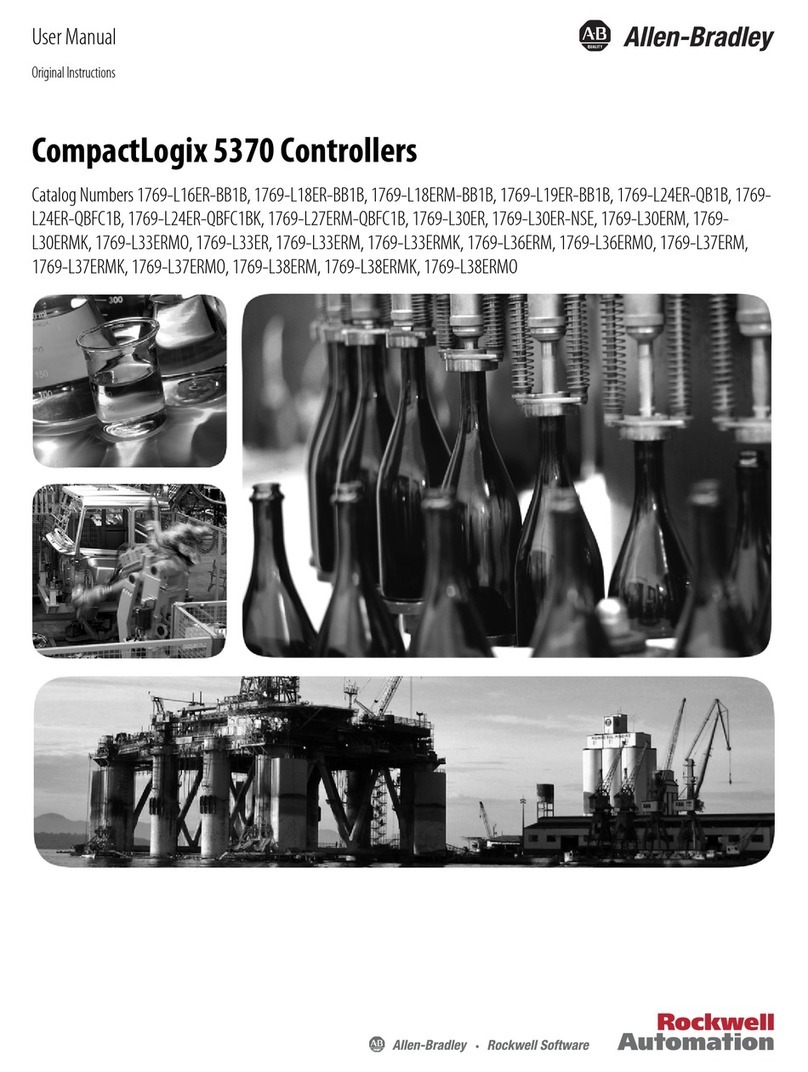
Rockwell Automation
Rockwell Automation Allen-Bradley CompactLogix 5370 user manual
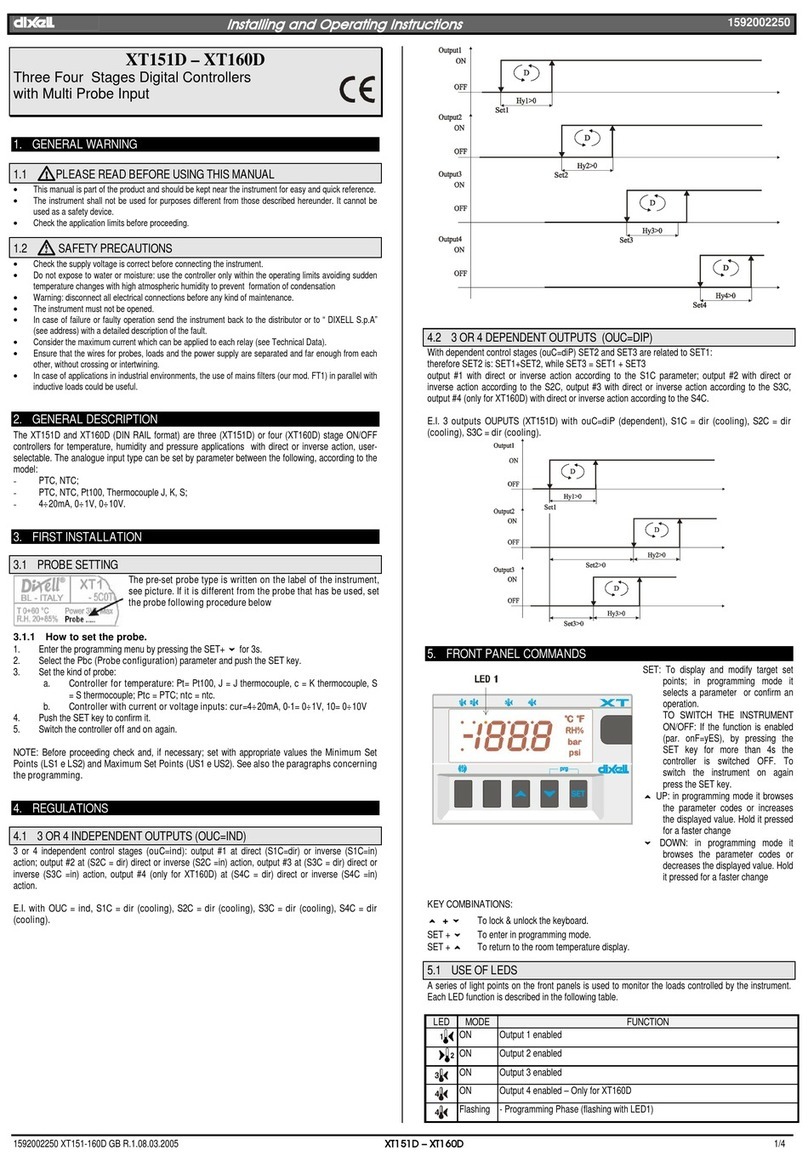
dixell
dixell XT151D Installing and operating instructions
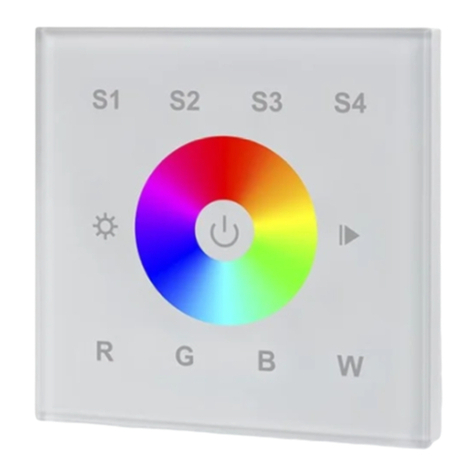
Sunricher
Sunricher SR-ZG9001T-RGBW manual

